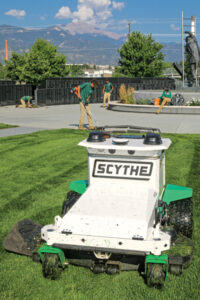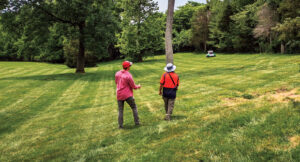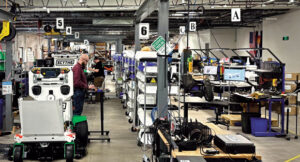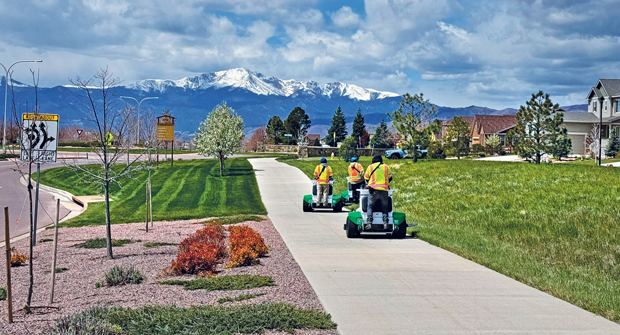
The landscape business might not be the first one you think of when it comes to cutting-edge technology and game-changing advances. And truth be told, the people most closely involved in trying to bring those kinds of things to the industry would probably agree with you.
“The thing that I find … kind of fascinating about this space is that the landscape industry is almost the last place you’d expect to see this type of technology,” says Billy Otteman, the senior director of brand at Scythe Robotics, a company working to make electric, autonomous commercial mowers more than just novelty items in landscaping.
“That’s actually what drew me to this opportunity. We’re using the same computer vision software and autonomous technology that Tesla is using in its self-driving cars and Apple is using in its new Vision Pro, but it’s in a space of businesses that have traditionally operated on whiteboards and paper. That’s exciting to be a part of change like that.”
To be clear, Scythe Robotics isn’t on an island here; landscapers and lawn care operators have a growing array of high-tech, battery-powered equipment solutions to choose from (see this month’s Innovation + Technology Guide for more on the latest and greatest tools to get the job done). And more and more end-users are embracing these machines in an effort to be more efficient, ease ongoing labor challenges and operate just a little more sustainably.
But it’s not a stretch to say that Scythe Robotics is writing an all-new chapter in this space with its M.52, the industry’s first all-electric, autonomous mower to be designed and built from the ground up to be that way. The company’s modest offices tucked into an office park on the outskirts of Longmont, Colo., might be an unlikely spot for a full-scale industry revolution, but that’s exactly what the Scythe team hopes is in the works.
“We had three criteria for the kind of product we’d develop and the space we wanted to get into. Commercial mowers and landscaping hit on all of them,” says company co-founder and CEO Jack Morrison. “First, the product had to actually be valuable to people. Second, we wanted it to not take a billion dollars to get to a finished product … to spend all this time and money and have nothing to show for it. And third, we wanted it to just be good for the world. We felt like robotics had the potential to … provide a value to this industry that people would pay for, and we think the M.52 hits on all three of those things.”
Origin story
Scythe Robotics’ origins can be traced to a series of tech endeavors that unwittingly brought the company’s co-founders together. Morrison and Isaac Roberts, now a company board member, connected during their time at Replica Labs, a software company that focused on 3D-scanning technology. When Occipital — another company in that same space — acquired Replica in 2016, Morrison and Roberts met Davis Foster, who was working as an electrical engineer at Occipital at the time. Two years later, he joined Morrison and Roberts in the early days of what would become Scythe and now serves as the company’s chief engineer.
The three men shared a passion for electrification and robotics, and a belief that those things could bring about positive societal change. But exactly how and where to apply those ambitions wasn’t clear at first, at least not until the light bulb went off for Morrison while tackling a task known to produce great thinking — mowing his lawn.

“We had an acre and a half about 10 minutes south (of Longmont), and I just hated mowing it,” he says with a laugh. “I grew up in the Chicago suburbs where it was grass lawns as far as you can see, and I was thinking about that while I was mowing mine. I went to Google later and was shocked to see there was almost 40 million acres of turfgrass in the U.S. It just seemed to check a lot of boxes for robotics, because if there’s one thing robots are good at, it’s going in straight lines. It resonated almost right off the bat.”
With commercial mowing now the focus of this new endeavor, the next step was identifying a target market.
Golf course maintenance soon rose to the top of the list, driven by the thought that the repetitive mowing that takes place on golf courses would be ideal for an autonomous device.
They quickly learned differently. “When we actually talked to a (golf course) superintendent, we discovered golf might not be the right fit,” Morrison says. “So many variables from course to course. I went and toured the Castle Pines course (in nearby Castle Rock, Colo.) … and that winds up and down the mountain with lots of big drops. I was like, ‘This seems like a good place for a robot to drive off a cliff,’ and that’s not a great business model.”
After scuttling their plans in golf — at least for the time being — they soon discovered that an adjacent industry would be a much better fit for their new enterprise.
“One of our co-founders (Roberts) knew a few commercial landscapers through friends of his family. After talking with them, it was pretty evident that it would be a great space for us. Larger properties, fewer variables in terms of size and shape than you see in golf,” Morrison says.
“The really interesting piece that we discovered is that landscapers don’t necessarily look at electrification and robotics as a way to just save on costs,” Morrison continues. “They actually look at it as a way to grow their business. They can take a crew of four, shift two of them onto another crew, then that crew with our machines can take on as many jobs as the other crew can without having to hire anybody else. It was a perspective we hadn’t really considered, but it did convince us that we were going down the right road.”
The sustainability part of the equation was another factor in deciding that mowing and landscaping were the right fit for Scythe, Otteman explains. “Contractors are getting demands from their clients where they want electric equipment on their properties, they want more sustainable solutions. Local governments are regulating it. Introducing all-electric, robotic mowers into the market helps mitigate those challenges.
“We’re really sitting at this intersection where we have an opportunity to use this technology to resolve both labor and environmental challenges for customers.”
Up and running

In early 2018, Scythe began work on its first prototype mower, nicknamed Astro, aiming to master the basics before moving into more technologically challenging territory. The M.52 represents the sixth iteration of that original machine, with each new version being christened with a nickname pulled from the country’s national park system — the first post-Astro prototype was Bighorn, the second Arapaho and the third Caribou.
The predecessor to the M.52 — a pre-production unit, so one step beyond a prototype but nothing that was ever mass produced — was known as Denali, and the current machine was dubbed Eldorado as it was coming online.
As one version gave way to another, extensive R&D work was ongoing, both to ensure the machines were technologically sound and that they could produce the reliability and quality of cut that contractors would expect. That work has included regular software improvements; the current M.52 is receiving updates, transmitted wirelessly, on an almost weekly basis. Since all mowers are regularly exposed to the elements, there has been wide-ranging testing to make sure the machine’s hardware was properly protected from heat and moisture. And the mowers have gone through hours of stress testing, both at company headquarters in Longmont and in the field, to make sure the sensitive hardware powering the machine can handle the day-to-day rigors of the job.
The M.52 is the first version to reach full production. Dozens of early adopters have been using the mower regularly for the past several months (see “Seeing is believing” on page 23), and by the end of 2024, Scythe hopes to have 100 machines in daily use with landscapers in Colorado, Texas, Florida and Ohio.
On its face, the M.52 looks like most traditional stand-on mowers and can be operated as such (more on that later). It features a 52-inch deck with a rear discharge, with motors that provide 15 horsepower in deck power and 20 horsepower in drive power and a top-end speed of 10 mph. But the machine’s feature list also notes its connectivity (2X LTE and Wi-Fi, by the way), which is when you start to notice that the M.52 isn’t just a traditional mower.
The mower uses computer vision to sense and navigate around different obstacles and respond accordingly based on its environment. The company used thousands of images to teach the mower to go around things such as trees, poles and park benches and stop when it encounters people, pets and other obstacles that might be in its way.
The end result is a machine that company officials like Otteman say will change the way landscapers think about how they allocate resources on a daily basis.
“We talk about the benefits of autonomy and electric power for end-users and the benefits from a sustainability aspect, but there’s an equal value in multiplying what landscape crews can do,” he says. “So, the M.52 is tackling the tedious task of mowing while at the same time giving the opportunity for the crew to go do higher-value, more-interesting work; work that they can get paid more for and then our customer can charge more for. That’s really the kind of the value proposition that most of our customers are interested in immediately.”
Easier entry into electric
The technology that powers the M.52 isn’t the only groundbreaking aspect to these machines. How landscapers actually get their hands on one also breaks plenty of industry norms.
Technically, customers don’t have an option to buy the M.52. “We never really considered selling these machines outright,” Morrison says. “We knew they were going to be expensive, and that would have been a deal-breaker right off the bat.”
Instead, Scythe has leaned into a leasing plan that closely matches many of the subscription models that are common in the start-up tech industry.
“Recurring revenue and subscriptions are all the rage in the start-up tech world where we came from,” Morrison says. “We never seriously thought about selling a mower subscription, though, because that would be a bit of a foreign concept for landscapers. But at the same time, there were lessons that we took from that idea.”
Scythe’s plan essentially has two parts. The base monthly lease gets customers the mower, maintenance on the machine and all-you-can-mow manual operation — as mentioned earlier, the M.52 can be operated like a traditional stand-on mower — with no hour cap. Layered on top of that is autonomous operation where customers pay on a monthly basis for every acre they mow.
Morrisson sees this plan as ideal for both the company and customer. The end-user gets a relatively low barrier of entry into autonomous technology and a tool that should allow them to do more with less and, eventually, land additional new business. For Scythe, the more the M.52 works, the more the company makes, so it’s incentivized to make the machine as efficient and reliable as possible with long-track battery power.
“There is a contractor we’re working with who has a goal to replace all his machines with ours eventually,” Morrison says. “If you’re buying those, you’re looking at 30 or 40 grand times 20 or 25 mowers. That’s a hefty investment. With this model, it gives companies the opportunity to get into the electric game a lot easier from the get-go. When it works right, it’s really a win-win.”
Coming attractions
Although early returns have been encouraging, the team at Scythe Robotics knows they have a long road to travel before achieving their mission, which Otteman describes as “pioneering solutions to more sustainably care for outdoor spaces and unlock growth for the businesses that maintain them.”
One such barrier, for example, is landscapers’ relative unfamiliarity with all-electric, autonomous equipment. “We’re on the vanguard of electrification in this industry … and the M.52 might be the first contact with large-scale electrification for a lot of companies,” Morrison says. “That’s something we have to keep in mind.”
The infrastructure available to charge these mowers might also present challenges.
“Even within one business, you might have different branches with incredibly different electrical infrastructure at the facilities, so that presents charging challenges,” Morrison says. “We have to get very specific with each of our partners to understand what we’re dealing with and how we can help solve those issues.”
Then there is Scythe’s almost completely analog production method for each M.52, which is probably more surprising than it is challenging. Despite being on the cutting edge of autonomous technology, there are very few automated processes when it comes to building each machine.
“At the end of the day, you can teach a human to do almost everything. It’s very difficult to teach a robot that same thing,” says Bryan Waltz, Scythe’s senior manager of production and field operations.
“I honestly think that we are probably two years away from any kind of meaningful automated production, which is OK because this vehicle is pretty complex. That allows us to have a team of people that have enough ambiguity in their jobs to keep them engaged and keep them learning.”
At the end of the day, though, Morrison doesn’t see those challenges as insurmountable. He holds a similar opinion about winning the hearts and minds of landscapers as they learn more about autonomous mowers.
“This is a very kick-the-tires industry, but I’ve been pleasantly surprised that the contractors we’ve worked with don’t need to kick the tires for very long to get what we’re trying to do and how it can benefit their business,” he says. “They will take risks and want to see this work, and that’s encouraging.”


